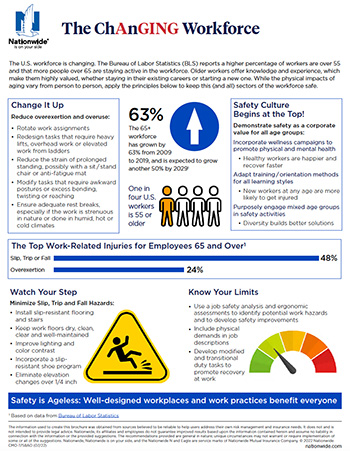Subscribe to our newsletter for timely content in your inbox

Aging within the workforce is not a new phenomenon. It is an expected part of the work and life cycle. However, workforce shortages and the need for skilled workers on the business side have combined with economic and social needs on the worker side resulting in an increase in the percentage of older workers in the workforce. Those beyond traditional retirement age growing at the fastest rate.1 In short, the workforce is aging, and data from the Bureau of Labor Statistics (BLS) indicates this trend is likely to continue. Is your business and its workforce ready for the future? Consider these key points.
With age comes an inescapable change in mental and physical abilities, but these do not necessarily lead to declining work performance or production. With experience comes the ability to plan and work smart. These learned abilities allow the experienced older workers to rely on their wisdom and less on physical strength and speed. The impact of aging on physiological attributes varies from person to person. This variance depends in part on lifestyle activity more than chronological aging.2
Businesses must not stereotype people on age but determine who can perform the job regardless of their age.3 This approach allows for equality in hiring qualified employees. Everyone brings different skills and abilities to employers. Employers must treat each candidate as a unique individual. To infer employees’ capabilities solely upon chronological age misses the fact that age does not match one to one with performance capacity.

Age does not mean employees are less capable of attaining production levels or learning new technologies and skills needed to compete in the workplace.3 Older workers are worth the investment. Business leaders, however, must consider the impact of an aging workforce in how they develop their safety programs and controls. To support this effort, an infographic on the ChAnGING Workforce has been created to highlight some key considerations and action points.
For example, slip, trip or fall events are a leading cause of injury for older workers. Since vision often declines with age, ensure that adequate lighting levels and the clear delineation of edges are in place to help to minimize this risk. Balance and range of motion may lessen. Consider changes to work tasks to lessen or eliminate the need for overhead work or work from ladders.
Aging workers can bring value to their employers, and while aging may require change, workers of all ages contribute varying knowledge, skills, and abilities. What you will find is, regardless of age, well-designed workplaces and work practices benefit everyone.
1 Based on data from Bureau of Labor Statistics
2 Kenny, G. P., Groeller, H., McGinn, R., & Flouris, A. D. (2016). Age, human performance, and physical employment standards. Applied Physiology, Nutrition, and Metabolism, 41(6 Suppl 2), S92–S107. https://doi.org/10.1139/apnm-2015-0483
3 Reade, N. (2015, September). Older workers are more valuable in the workforce. Retrieved from AARP website: http://www.aarp.org/work/job-hunting/info-07-2013/older-workers-more-valuable.html